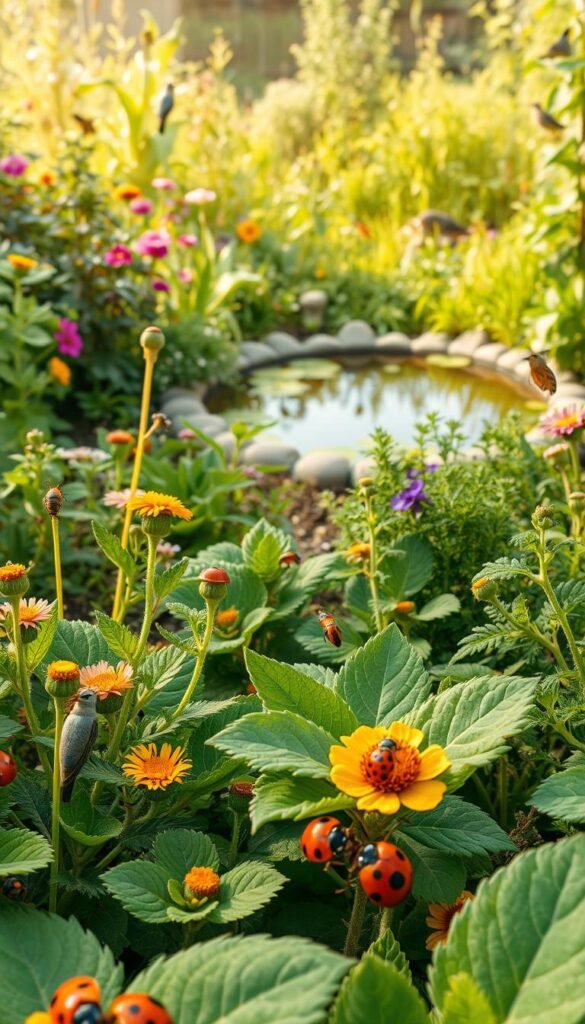Imagine stepping into your backyard to find thriving plants, buzzing pollinators, and pests managed without harsh sprays. This vision becomes reality when you prioritize methods that strengthen your green space’s natural defenses. Unlike synthetic solutions, these approaches protect soil health and create habitats where helpful insects thrive.
Studies show spaces using organic practices develop 50% fewer pest issues over time compared to chemical-reliant systems. Why? They foster balanced ecosystems where birds, ladybugs, and other predators keep unwanted visitors in check. You’ll also avoid contaminating groundwater or leaving residues on homegrown tomatoes and herbs.
Many effective natural pest control strategies use items already in your kitchen or local nursery. From companion planting to homemade sprays, these solutions save money while supporting biodiversity. They’re particularly valuable for families and pet owners seeking safer alternatives.
As you’ll discover, working with nature’s rhythms yields tastier harvests and reduces maintenance long-term. Let’s explore how simple changes can transform your outdoor area into a self-regulating sanctuary that benefits both your household and local wildlife.
Understanding the Benefits of a Chemical-Free Garden

A chemical-free garden isn’t just about what you remove—it’s about what you cultivate. By working with nature’s rhythms, you create spaces where life thrives above and below the soil. Let’s break down why this approach delivers lasting results.
Natural Ecosystem Advantages
Your yard becomes a living network when you avoid synthetic sprays. Ladybugs patrol for aphids, while earthworms aerate soil. These relationships form a self-regulating system that grows stronger yearly. Research reveals:
| Method | Beneficial Insects | Soil Microbes |
|---|---|---|
| Chemical Use | Decline by 70% | Reduced diversity |
| Organic Care | Increase by 45% | Thrive naturally |
This balance explains why organic plots see 50% fewer infestations over time. As one study notes:
“Gardens managed without chemicals develop natural resilience through predator-prey dynamics.”
Health and Environmental Impacts
Every synthetic spray leaves a footprint. Runoff contaminates waterways, while residues linger on produce. Switching to natural methods:
- Protects groundwater quality
- Eliminates toxic exposure risks
- Supports declining bee populations
Families gain peace of mind knowing kids and pets explore safely. For those exploring sustainable layouts, chemical-free practices align perfectly with permaculture’s core ideas. You’re not just growing plants—you’re nurturing an entire habitat.
Getting Started with Your Natural Garden
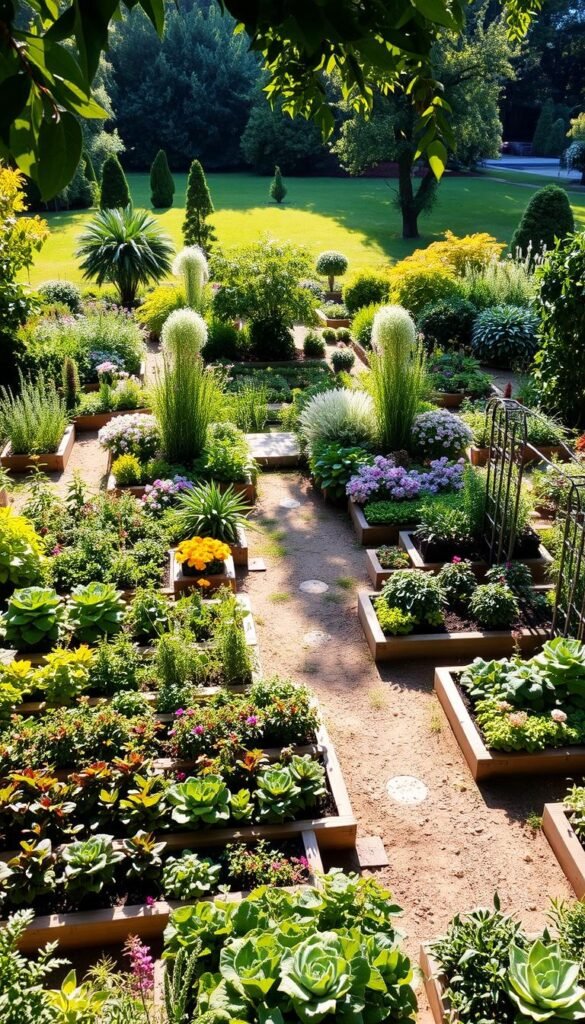
Transforming your outdoor space starts with smart preparation. A well-designed layout acts as your first defense against pests while nurturing plants and beneficial species. Let’s map out how to create harmony between your green ambitions and nature’s rhythms.
Planning Your Garden Layout
Sunlight and airflow matter more than you think. Position taller crops like tomatoes on the north side to avoid shading shorter herbs. Leave pathways wide enough for easy access—this prevents soil compaction and reduces pest-friendly damp spots.
| Layout Choice | Benefits | Risks |
|---|---|---|
| Grouped Plant Families | Simplifies pest monitoring | Requires spacing knowledge |
| Mixed Planting | Confuses pests naturally | Needs companion research |
Avoid burying trimmed leaves or stems—they become pest hotels. Instead, compost them properly. For soil prep, consider chemical-free haven techniques like adding worm castings or leaf mold.
Setting Realistic Goals for a Chemical-Free Zone
Don’t expect overnight miracles. It takes 1-3 seasons for predator insects to establish populations. Track progress through:
- Reduced aphid clusters
- Increased ladybug sightings
- Healthier plant roots
Start small—convert one raised bed this year. As one urban gardener noted:
“Patience rewards you with strawberries that taste like childhood memories.”
Building a Natural Garden: Avoiding Chemicals and Embracing Natural Pest Control
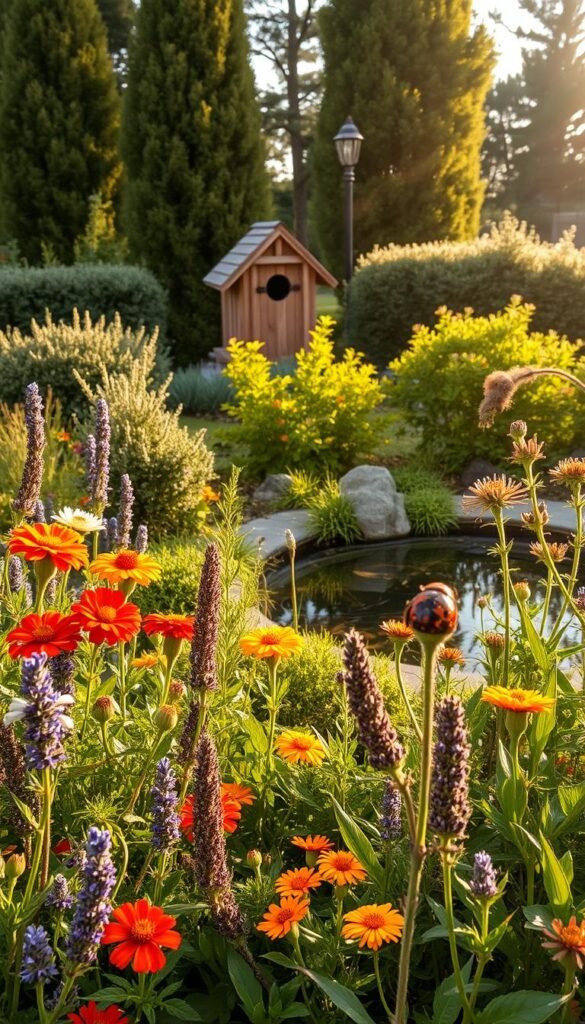
Healthy gardens thrive when you work with nature’s rhythms rather than against them. Integrated Pest Management (IPM) offers a science-backed framework that combines observation, prevention, and minimal intervention. This approach helps you address issues before they escalate while letting beneficial species do the heavy lifting.
Key Principles of Natural Pest Management
IPM revolves around four core steps that prioritize ecosystem health:
| Step | Action | Impact |
|---|---|---|
| Monitor | Weekly plant inspections | Early problem detection |
| Identify | Use magnifying glass/apps | Target correct pests |
| Prevent | Crop rotation + spacing | Reduce vulnerabilities |
| Control | Organic sprays last | Protect allies |
This system cuts chemical use by up to 80% while maintaining yields. As one USDA study found:
“IPM adopters see 40% lower pest damage compared to conventional methods within three seasons.”
Integrating Organic Methods into Your Routine
Make pest checks part of daily gardening. Morning walks help spot chewed leaves before coffee. Evening sprays using garlic oil or neem disrupt pests’ feeding cycles without harming ladybugs.
For eco-friendly pest control solutions, combine physical barriers with companion plants. Marigolds repel nematodes, while basil confuses tomato hornworms. Remember: a few aphids feed predator populations – only treat when damage exceeds 10% of leaves.
Natural Pest Control Techniques to Embrace
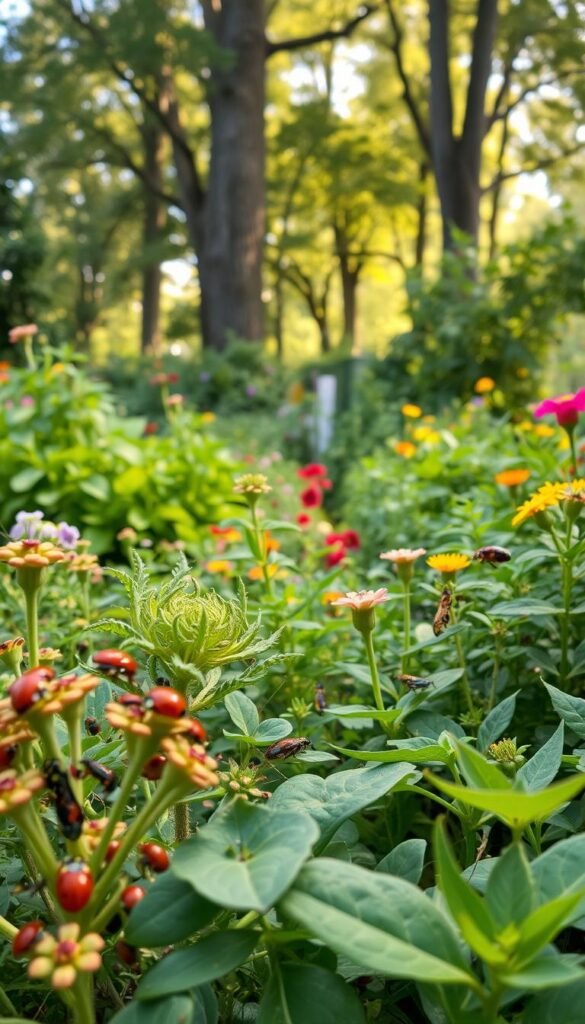
Your garden’s first line of defense starts with your own two hands. Early intervention through simple methods often stops infestations before they escalate. Let’s explore how manual efforts and kitchen staples create powerful protection systems.
Manual Removal and Physical Barriers
Blast aphids off leaves with a strong water spray—they rarely return after this shower. For slugs, place halved grapefruit shells as overnight traps, then relocate these slimy visitors in the morning. Squeeze leaf miner tunnels between your fingers to stop larvae without harming plants.
Physical barriers act like bouncers for your garden:
- Insect mesh blocks carrot flies and cabbage moths
- Floating row covers let sunlight through while deterring beetles
- Crushed eggshells form protective moats around seedlings
Organic Sprays and Homemade Remedies
Whip up pest solutions while making dinner. A garlic spray (two bulbs blended with water) repels 80% of soft-bodied insects when applied at dusk. Dawn dish soap mixed with water dissolves aphid coatings—just rinse plants after 20 minutes.
One gardener shared: “My tomato plants rebounded within days after using the soap spray method from organic solutions that work.” Always test sprays on single leaves first, and reapply after rain.
Attracting Beneficial Insects and Encouraging Natural Predators
What if your garden could defend itself? By inviting nature’s pest control squad, you create a living security system. Beneficial insects like ladybugs and lacewings patrol your plants, devouring up to 5,000 aphids per lifetime or attacking 200+ pest species.
Companion Planting Strategies
Turn herbs into pest-fighting allies through strategic pairings. These plants pull double duty – repelling troublemakers while feeding protective species:
- Dill & fennel: Lure lacewings and parasitic wasps that target mealybugs
- Parsley & thyme: Attract hoverflies whose larvae eat aphids
- Marigolds: Repel root-eating nematodes while drawing ladybugs
Creating Insect-Friendly Habitats
Your helpers need three things to stick around: food, water, and shelter. Plant flowers like cosmos and yarrow that bloom at different times for continuous nectar. Leave some leaf litter or stack hollow stems for overwintering spots.
Set up watering stations with pebble-filled dishes – shallow edges prevent drownings. As one grower observed: “Since adding a beneficial insect habitat, my kale plants haven’t needed a single spray.” Avoid pesticides, even organic ones, unless absolutely necessary.
Utilizing Natural Barriers and Traps for Pest Control
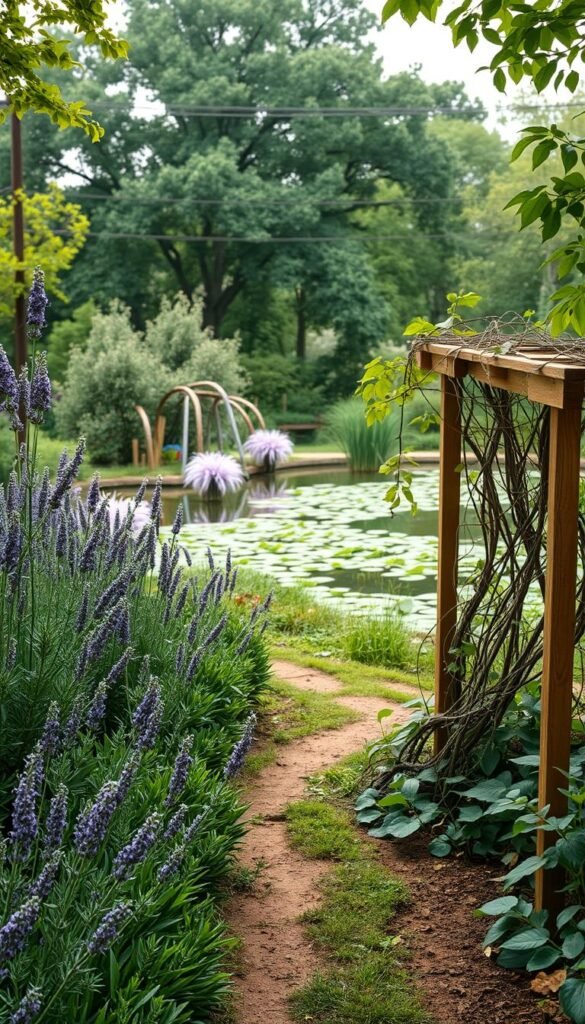
Turn your garden into a fortress without harsh chemicals by deploying smart barriers and targeted traps. These methods block invaders before they reach your plants while capturing those that slip through. It’s like having a security system tailored to your green space’s unique needs.
Using Covers, Meshes, and Netting Effectively
Physical barriers act as your garden’s first line of defense. Copper tape wrapped around planter edges delivers a mild static charge that deters slugs mid-crawl. Floating row covers made of lightweight fabric let sunlight and rain through while shielding plants from beetles and moths.
| Barrier Type | Best For | Installation Tip |
|---|---|---|
| Insect Mesh | Aphids, whiteflies | Secure edges with rocks |
| Bird Netting | Sparrows, squirrels | Elevate above plants |
| Kaolin Clay Spray | Leaf-eating insects | Reapply after rain |
Pair these with clever traps for full-spectrum protection. Bury shallow containers filled with beer to attract and drown slugs overnight. Hang yellow sticky cards near tomatoes – their bright color lures whiteflies away from your crop.
Timing matters most. Install barriers at planting time and refresh clay sprays every 10 days. One gardener noted: “Since using copper tape and beer traps, my hostas haven’t had a single slug hole.” Monitor weekly and adjust your strategy as pest activity shifts.
Enhancing Soil Health and Sustainable Gardening Practices
Your garden’s resilience starts beneath the surface. Nutrient-rich earth acts like a fortress, growing plants that pests avoid naturally. By focusing on soil care and smart habits, you create conditions where problems struggle to take root.
Soil Fertility and Composting Techniques
Healthy soil grows resilient crops. Mix kitchen scraps with yard waste using a 2:1 brown-to-green ratio for fast-breaking compost. This “black gold” feeds microbes that boost plant immunity. For potassium-loving veggies like cucumbers, add greensand to beds—it stops beetles while improving water retention.
Consider no-dig methods to preserve soil structure. Layering compost on top protects worms and prevents weed growth. One study found no-dig beds hold 30% more moisture during droughts compared to tilled plots.
Crop Rotation and Smart Water Management
Rotate plant families yearly to confuse pests. Tomatoes follow beans to balance nitrogen levels, while carrots move where onions grew. Pair this with drip irrigation—it delivers water straight to roots, cutting fungal risks by 60%.
Water early so leaves dry by noon. Overwatering invites slugs, but proper drainage keeps their eggs from hatching. Mulch with straw or wood chips to lock in moisture and block weeds. Your soil will thank you with tastier harvests.

